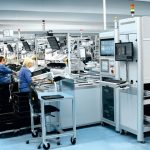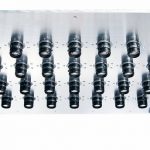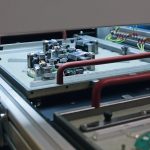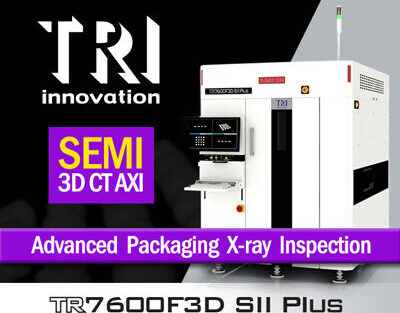ebm-papst has a vast product range. For the most part, it is centred around fans, blowers and pumps. Some products are just a few centimetres in size, with others measuring over a metre in diameter. They have one thing in common: they all need electronics. At its site in Mulfingen, Germany, the company manufactures approximately 650,000 assemblies per month, around half a million of which are THT assemblies – mathematically speaking, that means that three quarters of all assemblies have components that are soldered using through-hole technology. The fact that such a large number of assemblies also have to be tested is a logical consequence of this. There are various different systems from different manufacturers for automatic optical inspection (AOI), in particular for THT components. A special requirement for a new testing system for ebm-papst was ultimately what saw the contract awarded to the MultiCam Line from Göpel electronic: an exceptionally small system footprint, along with outstanding performance.
High quality production
At the production site, PCBs are assembled on a total of eight SMD lines and one THT line. The THT production line consists of 12 manual assembly stations, where components are fitted to the PCB by hand. The assemblies are automatically transported into the line on a workpiece carrier and to the respective workstations. Each of the assemblies is then navigated to its assigned assembly stations using an RFID code. This is all fully automated, which at the same time ensures enormous efficiency when there are around 1,000 different product variants. Once the respective THT components have been mounted on the PCBs, which are already fitted with SMD components, the components are then soldered in a final step using wave soldering. At ebm-papst, an automatic inspection is carried out before soldering, however. For Tobias Brand, process developer in Mulfingen, the advantages of this are clear: “Repairing an incorrectly mounted THT component after soldering involves a great deal of effort. If you can identify the error early, that saves time and money.” When it came to installing an inspection system between manual assembly stations and the soldering furnace, however, the problem was one of a lack of space. Because the production line as it was had already reached its limits when it came to space, the MultiCam Line impressed with its ability to be integrated easily into the production line with a footprint of just 660 mm x 760 mm. The highlight of the whole thing is that the system manages without any kind of axis system for the camera module and thus operates completely wear-free.
The solution is to save space
The secret to saving space and zero maintenance is the image-capture module by the name of MultiEyeS. It consists of a matrix arrangement of multiple cameras. The image capture from all cameras takes place virtually simultaneously. The individual images are then automatically assembled to form an overall picture. This technology has now become common in smartphone cameras thanks to panorama features and is known as ‘stitching’.
In the system software Pilot 6, the individual images are combined to form an overall picture using a stitching algorithm that is optimised for the application in question. This means that there are a total of 12,000 x 10,000 colour pixels, i.e. a total of 120 megapixels, available for image capture of the inspection area. Since the image capture of the cameras is performed as far as possible in parallel and the stitching algorithm is trimmed for speed, a full-surface image of an assembly measuring 490 mm x 390 mm can be captured and processed in less than 5 seconds. With a physical resolution of 40 μm, the MultiEyeS image-capture module is aimed in particular at inspection tasks for THT placement monitoring – for example presence, positional accuracy and polarity. Because THT components differ greatly in size, different focal planes can be set in the inspection process according to requirements. This can vary from 2 mm to 100 mm, which means a high clearance height and at the same time a high degree of flexibility in the inspection.
Looking back, Tobias Brand is very satisfied with the decision to choose the MultiCam Line for THT inspection. “Following the installation at our site in Mulfingen, we also added more systems at our production site in Hungary.” The test programs are created in Germany and transferred to Hungary. Because the production sites are networked, adjustments can be made to the test programs quickly and easily from Germany. The programming is carried out quickly, and the component library is now well stocked. “It takes little more than half an hour to create the test programs,” observes Tobias Brand in conclusion. With the high speed of programming and of the test procedure as well as its wear-free operation, the MultiCam Line at ebm-papst does exactly what it claims to do: it finds errors early, before it’s too late – and in the tightest spaces.
www.goepel.com; www.ebmpapst.com
Zusammenfassung
Die Leistungselektronik eines Herstellers von Ventilatoren und Elektromotoren benötigen THT-Komponenten. Baugruppen, die zuverlässige Qualitätssicherung erfordern, wozu ein System mit außergewöhnlichem kleinem Platzbedarf bei gleichzeitig hervorragender Leistung gesucht wurde.
Résumé
La puissance électronique pour des ventilateurs et des moteurs électriques nécessite des composants THT. La clientèle recherche des composants d’une qualité fiable et comprenant un système avec un encombrement adapté et des performances optimales.
Резюме
В силовой электронике производителя вентиляторов и электродвигателей активно применяются компоненты для сквозного монтажа в отверстия (THT). Эти узлы требуют серьезного контроля качества. Для этого производитель ищет компактную систему, обеспечивающую при этом высокий уровень производительности.













